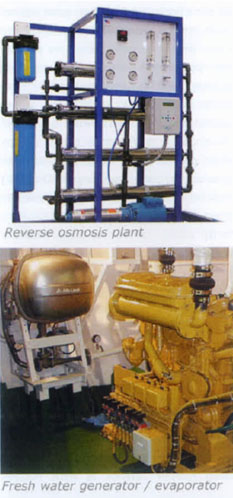Fresh water on board
Fresh water on board
Vessels with unlimited navigation area have their own fresh water production. The two main methods are using the heat generated by the engine and reverse osmosis .
Traditional desalination plants use the heat of the exhaust gas to vaporize seawater and convert the steam to fresh water in a condenser. Another option is another brilliant engineering notion called a vaporizer . It uses the low temperature heat of the main engine cooling water.

Seawater is pumped into the evaporator and heated in a heat exchanger to a temperature of about 40 ° C. An additional amount of seawater is pumped into the other part of the evaporator through the ejector, thereby creating a significant vacuum, at which the heated water intensively evaporates (or boils). The vapor enters the cold part of the evaporator, where it condenses in a cold seawater heat exchanger. Fresh water is pumped into a reservoir. The concentrated brine remaining from the heated water remains at the bottom of the evaporator and is removed from there.
Reverse osmosis technology is that purified seawater is pumped under high pressure over a special semi-permeable filter membrane with holes so small that a water molecule can pass through them, but a salt molecule cannot. The outlet is fresh water (one liter for several liters of pumped water). The process itself requires a certain amount of energy.
The water obtained by both the first and the second methods is practically distilled, it is not very convenient to use it - for example, it is difficult to wash off the soap. This is solved by adding mineral salts. Water passes through special mineralizing cartridges. Such water is quite suitable for drinking, but sometimes ships have separate tanks with a supply of drinking water.
And for the crew, bottled water is sometimes purchased, as well as Coca-Cola and other soft drinks to satisfy their thirst. Including non-alcoholic beer.
 +7 (812) 4-673-673
+7 (812) 4-673-673